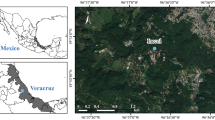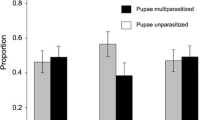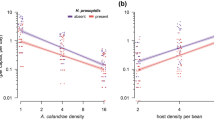Abstract
Most insect populations are exploited by a complex of different parasitoid species, providing ample opportunities for competitive interactions among the latter. Despite this, resource-mediated competition (i.e., exploitative competition) among insect parasitoids remains poorly documented in natural systems. Here we propose a novel way to infer the presence of competitive interactions from covariance patterns in parasitism levels, and illustrate the use of this approach on a relatively well-defined and simple host–parasitoid system. The parasitism levels caused by three parasitoid species on a shared host showed a highly consistent negative covariance among samples. With the levels of parasitism by one species increasing, the levels of parasitism attributable to the two others decreased. Importantly, negative covariance between parasitism levels by different species appeared at high abundance, but not at low abundance of the phenologically earlier parasitoid species. This as well as several other lines of evidence indicates the importance of competitive interactions in this system. Feeding biology and phenology of the parasitoids suggest that competition in this parasitoid assemblage is primarily resource-mediated rather than occurring through direct interference. The species attacking earlier stages of the host are competitively superior to those attacking their host later in the season. Better dispersal ability and use of alternative host species by the inferior species could contribute to the coexistence of these competing parasitoids.



Similar content being viewed by others
References
Abrams PA (2001) The effect of density-independent mortality on the coexistence of exploitative competitors for renewing resources. Am Nat 158:459–470
Amarasekare P, Nisbet RM (2001) Spatial heterogeneity, source–sink dynamics, and the local coexistence of competing species. Am Nat 158:572–584
Briggs CJ (1993) Competition among parasitoid species on a stage-structured host and its effect on host suppression. Am Nat 141:372–397
Brodmann PA, Wilcox CV, Harrison S (1997) Mobile parasitoids may restrict the spatial spread of an insect outbreak. J Anim Ecol 66:65–72
Cappuccino N, Lavertu D, Bergeron Y, Regniere J (1998) Spruce budworm impact, abundance and parasitism rate in a patchy landscape. Oecologia 114:236–242
Chaneton EJ, Bonsall MB (2000) Enemy-mediated apparent competition: empirical patterns and the evidence. Oikos 88:380–394
Collier TR, Hunter MS (2001) Lethal interference competition in the whitefly parasitoids Eretmocerus eremicus and Encarsia sophia. Oecologia 129:147–154
Collier TR, Hunter MS, Kelly SE (2007) Heterospecific ovicide influences the outcome of competition between two endoparasitoids, Encarsia formosa and Encarsia luteola. Ecol Entomol 32:70–75
Connell JH (1983) On the prevalence and relative importance of interspecific competition: evidence from field experiments. Am Nat 122:661–696
Galichet PF, Cousin M, Girard R (1992) Egg dormancy and synchronization of larval feeding with host plant development in three noctuid (Lepidoptera) species. Acta Oecol 13:701–714
Geervliet JBF, Verdel MSW, Snellen H, Schaub J, Dicke M, Vet LEM (2000) Coexistence and niche segregation by field populations of the parasitoids Cotesia glomerata and C. rubecula in the Netherlands: predicting field performance from laboratory data. Oecologia 124:55–63
Hanski I (1983) Coexistence of competitors in patchy environment. Ecology 64:493–500
Harvey JA, Gols R, Strand MR (2009) Intrinsic competition and its effects on the survival and development of three species of endoparasitoid wasps. Entomol Exp Appl 130:238–248
Hassell MP, Comins HN, May RM (1994) Species coexistence and self-organizing spatial dynamics. Nature 370:290–292
Hawkins BA (1990) Global patterns of parasitoid assemblage size. J Anim Ecol 59:57–72
Hawkins BA (2000) Species coexistence in parasitoid communities: does competition matter? In: Hochberg ME, Ives AR (eds) Parasitoid population biology. Princeton University Press, Princeton, pp 198–213
Hawkins BA, Lawton JH (1987) Species richness for parasitoids of British phytophagous insects. Nature 326:788–790
Hemerik L, Driessen G, Haccou P (1993) Effects of intra-patch experiences on patch time, search time and searching efficiency of the parasitoid Leptopilina clavipes. J Anim Ecol 62:33–44
Hinz R (1983) The biology of the European species of the genus Ichneumon and related species (Hymenoptera: Ichneumonidae). Contr Am Entomol Inst 20:151–152
Hinz R, Horstmann K (1999) Zur Lebensweise der europäischen Arten von Chasmias Ashmead, 1900 und Limerodops Heinrich, 1949 (Hymenoptera, Ichneumonidae, Ichneumoninae). Entomofauna 20:301–308 (in German with English abstract)
Hinz R, Horstmann K (2000) Die westpaläarktischen Arten von Exephanes Wesmael. Spixiana 23:15–32 (in German with English abstract)
Iwao K, Ohsaki N (1996) Inter- and intraspecific interactions among larvae of specialist and generalist parasitoids. Res Popul Ecol 38:265–273
Kaplan I, Denno RF (2007) Interspecific interactions in phytophagous insects revisited: a quantitative assessment of competition theory. Ecol Lett 10:977–994
Knight GA, Lavigne RJ, Pogue MG (1991) The parasitoid complex of forest tent caterpillar, Malacosoma disstria (Lepidoptera: Lasiocampidae), in eastern Wyoming shelterbelts. Great Lakes Entomol 24:255–261
Kuhlmann U, Carl KP, Mills NJ (1998) Quantifying the impact of insect predators and parasitoids on populations of the apple ermine moth, Yponomeuta malinellus (Lepidoptera: Yponomeutidae), in Europe. Bull Entomol Res 88:165–175
Lei G, Hanski I (1998) Spatial dynamics of two competing specialist parasitoids in a host metapopulation. J Anim Ecol 67:422–433
Luck RF, Podoler H (1985) Competitive exclusion of Aphytis lingnanensis by A. melinus: potential role of host size. Ecology 66:904–913
Müller CB, Godfray HCJ (1999) Indirect interactions in aphid–parasitoid communities. Res Popul Ecol 41:93–106
Münster–Swendsen M (1982) Interactions within a one-host-two-parasitoids system, studied by simulations of spatial patterning. J Anim Ecol 51:97–110
Olofsson E (1987) Mortality factors in a population of Neodiprion sertifer (Hymenoptera: Diprionidae). Oikos 48:297–303
Outreman Y, Pierre JS (2005) Adaptive value of host discrimination in parasitoids: when host defences are very costly. Behav Process 70:93–103
Outreman Y, Le Ralec A, Wajnberg E, Pierre JS (2001) Can imperfect host discrimination explain partial patch exploitation in parasitoids? Ecol Entomol 26:271–280
Parry D (1995) Larval and pupal parasitism of the forest tent caterpillar, Malacosoma disstria Hübner (Lepidoptera: Lasiocampidae) in Alberta, Canada. Can Entomol 127:877–893
Pijls JWAM, van Alphen JJM (1996) On the coexistence of the cassava mealybug parasitoids Apoanagyrus diversicornis and A. lopezi (Hymenoptera: Encyrtidae) in their native South America. Bull Entomol Res 86:51–59
Schoener TW (1983) Field experiments on interspecific competition. Am Nat 122:240–285
Skou P (1991) Nordens Ugler. Håndbog over de i Danmark, Norge, Sverige, Finland og Island forekommende arter af Herminiidae og Noctuidae (Lepidoptera). Danmarks Dyreliv 5, Apollo Books, Stenstrup (in Danish)
Teder T (2001) Direct and indirect effects in host-parasitoid interactions: ecological and evolutionary consequences. PhD Dissertation, University of Tartu, Tartu, Estonia
Teder T, Tammaru T (2002) Cascading effects of plant vigour on the relative performance of insect herbivores and their parasitoids. Ecol Entomol 27:94–104
Teder T, Tammaru T (2003) Short-term indirect interactions between two moth species mediated by shared parasitoids: the benefit of being scarce. Eur J Entomol 100:323–328
Teder T, Tammaru T, Pedmanson R (1999) Patterns of host use in solitary parasitoids (Hymenoptera: Ichneumonidae): field evidence from a homogenous habitat. Ecography 22:79–86
van Baalen M, Křivan V, van Rijn PCJ, Sabelis MW (2001) Alternative food, switching predators, and the persistence of predator-prey systems. Am Nat 157:512–524
Wang X-G, Messing RH, Bautista RC (2003) Competitive superiority of early acting species: a case study of opiine fruit fly parasitoids. Biocontrol Sci Techn 13:391–402
Yamamoto D, Henderson R, Corley LS, Iwabuchi K (2007) Intrinsic, inter-specific competition between egg, egg-larval, and larval parasitoids of plusiine loopers. Ecol Entomol 32:221–228
Acknowledgments
We thank Robert B. Davis, Toomas Esperk, Juhan Javoiš, Ly Lindman, Freerk Molleman, Anu Tiitsaar and Helen Vellau for helpful comments, and Rein Karulaas for the help during field works. The study was supported by the Estonian Science Foundation (grant no. 8413), the Estonian Ministry of Education and Science (targeted financing project SF0180122s08), and the EU through the European Regional Development Fund (Centre of Excellence FIBIR).
Author information
Authors and Affiliations
Corresponding author
Rights and permissions
About this article
Cite this article
Teder, T., Tammaru, T. & Kaasik, A. Exploitative competition and coexistence in a parasitoid assemblage. Popul Ecol 55, 77–86 (2013). https://doi.org/10.1007/s10144-012-0341-6
Received:
Accepted:
Published:
Issue Date:
DOI: https://doi.org/10.1007/s10144-012-0341-6




